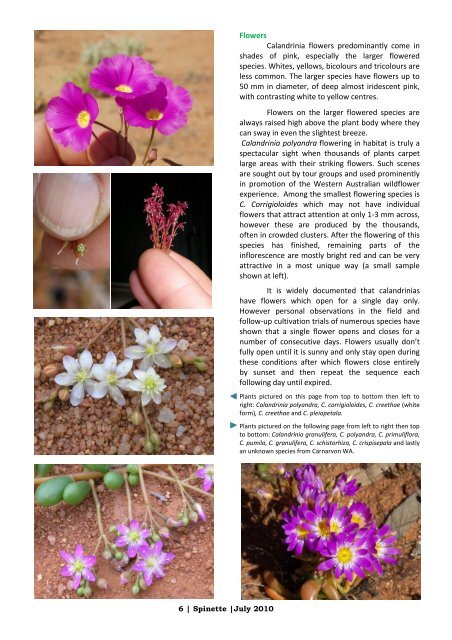Spinette July 2010 Journal of The Cactus and Succulent Society of ...
Spinette July 2010 Journal of The Cactus and Succulent Society of ...
Spinette July 2010 Journal of The Cactus and Succulent Society of ...
You also want an ePaper? Increase the reach of your titles
YUMPU automatically turns print PDFs into web optimized ePapers that Google loves.
6 | <strong>Spinette</strong> |<strong>July</strong> <strong>2010</strong><br />
Flowers<br />
Cal<strong>and</strong>rinia flowers predominantly come in<br />
shades <strong>of</strong> pink, especially the larger flowered<br />
species. Whites, yellows, bicolours <strong>and</strong> tricolours are<br />
less common. <strong>The</strong> larger species have flowers up to<br />
50 mm in diameter, <strong>of</strong> deep almost iridescent pink,<br />
with contrasting white to yellow centres.<br />
Flowers on the larger flowered species are<br />
always raised high above the plant body where they<br />
can sway in even the slightest breeze.<br />
Cal<strong>and</strong>rinia poly<strong>and</strong>ra flowering in habitat is truly a<br />
spectacular sight when thous<strong>and</strong>s <strong>of</strong> plants carpet<br />
large areas with their striking flowers. Such scenes<br />
are sought out by tour groups <strong>and</strong> used prominently<br />
in promotion <strong>of</strong> the Western Australian wildflower<br />
experience. Among the smallest flowering species is<br />
C. Corrigioloides which may not have individual<br />
flowers that attract attention at only 1-3 mm across,<br />
however these are produced by the thous<strong>and</strong>s,<br />
<strong>of</strong>ten in crowded clusters. After the flowering <strong>of</strong> this<br />
species has finished, remaining parts <strong>of</strong> the<br />
inflorescence are mostly bright red <strong>and</strong> can be very<br />
attractive in a most unique way (a small sample<br />
shown at left).<br />
It is widely documented that cal<strong>and</strong>rinias<br />
have flowers which open for a single day only.<br />
However personal observations in the field <strong>and</strong><br />
follow-up cultivation trials <strong>of</strong> numerous species have<br />
shown that a single flower opens <strong>and</strong> closes for a<br />
number <strong>of</strong> consecutive days. Flowers usually don’t<br />
fully open until it is sunny <strong>and</strong> only stay open during<br />
these conditions after which flowers close entirely<br />
by sunset <strong>and</strong> then repeat the sequence each<br />
following day until expired.<br />
Plants pictured on this page from top to bottom then left to<br />
right: Cal<strong>and</strong>rinia poly<strong>and</strong>ra, C. corrigioloides, C. creethae (white<br />
form), C. creethae <strong>and</strong> C. pleiopetala.<br />
Plants pictured on the following page from left to right then top<br />
to bottom: Cal<strong>and</strong>rinia granulifera, C. poly<strong>and</strong>ra, C. primuliflora,<br />
C. pumila, C. granulifera, C. schistorhiza, C. crispisepala <strong>and</strong> lastly<br />
an unknown species from Carnarvon WA.



